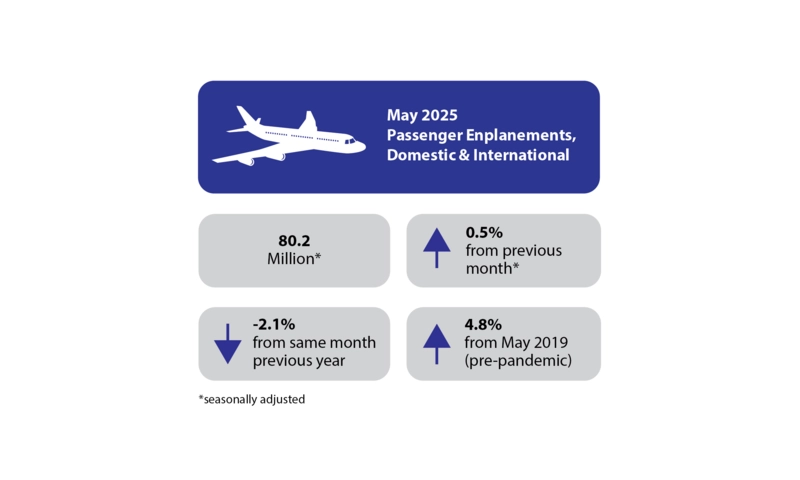Passenger Traffic Overview
In May 2025, U.S. airlines reported carrying approximately 85.2 million scheduled service passengers, which encompasses both domestic and international flights. This figure represents a decrease of 2.1% compared to the same month in the previous year, as documented by the Bureau of Transportation Statistics (BTS). When analyzed with a seasonal adjustment, May’s enplanements reflect a slight increase of 0.5% from April. However, it still falls short by 3.5% from the peak observed in June 2024.
Domestic and International Passenger Statistics
The breakdown of the passenger numbers reveals that about 74.2 million of these travelers were domestic passengers, while around 11 million took international flights. Notably, these figures are reported without any seasonal adjustments, indicating ongoing volatility in airline traffic.
Key Trends in Passenger Enplanements
Tracking the trends in passenger enplanements for U.S. airlines reveals some notable fluctuations. The volume of travelers is often influenced by various factors such as travel demand fluctuations, pricing strategies, and seasonality. An analysis of trends from prior months indicates a gradual uptick in travel since the onset of the year, albeit with this marked decline in May. Such patterns could signal potential areas of improvement for airlines to capitalize on.
Contextual Factors Influencing Travel
Several factors may have contributed to this dip in passenger traffic. Economic conditions, competitive pricing, and changing consumer preferences play a significant role in travel habits. Additionally, as overall travel appears to be on an upward trajectory following the disruptions caused by the pandemic, this recent downturn will have airlines re-evaluating their operational strategies.
Historical Analysis of Air Travel in the U.S.
The history of air travel in the United States has been marked by significant growth and transformation. The airline industry has evolved dramatically since the establishment of scheduled flights in the early 20th century. The first commercial flights were often short and catered to a limited audience, but as technology advanced and the general public’s interest in air travel grew, airlines began expanding their networks.
Past Growth Trends
Between the 1980s and early 2000s, deregulation transformed the industry, enabling more airlines to enter the market and increasing competition. This era brought about innovative pricing strategies and the introduction of low-cost carriers, changing the travel landscape. Despite challenges such as economic recessions and global events impacting travel, air traffic has steadily increased over the years.
The Future of Air Travel in Context of Tourism
Looking ahead, the significance of these traffic trends goes beyond just the airlines themselves. Air travel plays a critical role in international tourism, connecting destinations across the globe. Adverse trends in air traffic may suggest potential challenges for tourism operators and local economies that heavily rely on visitors arriving by air.
International Tourism Insights
With the rise of international travel, particularly from emerging markets, airlines are under pressure to ensure reliable and affordable services. The growth in tourism has increased the demand for air travel, leading many analysts to predict that, despite short-term fluctuations, the long-term outlook remains optimistic, provided the industry adapts effectively to changing consumer needs.
Impact on Travel Providers
As the dynamics of air travel evolve, travel providers must consider how fluctuations in passenger numbers influence overall demand for related services, including accommodations, ground transportation, and leisure activities. A subtle dip in traffic could prompt travel agencies and tour operators to reconsider their marketing strategies and promotional efforts to emphasize unique selling points that appeal to cost-conscious travelers.
Passenger Traffic Summary for May 2025
Recent calculations from the Bureau of Transportation Statistics illustrate that U.S. airline traffic experienced a notable decline, with 2.1% fewer passengers than last year during May. Utilizing statistical analysis, it is clear that domestic flights constitute the majority of this data, indicating strong support for local travel even amidst international travel uncertainties.
Schlussfolgerung
As analyzed, the recent data on U.S. airline traffic presents a multifaceted look into the current state of the industry, with implications reaching into tourism and travel operations. For marine enthusiasts and those looking to explore beautiful coastal destinations, understanding these trends can also influence choices related to boating trips and yacht charters. Services like GetBoat.de provide an international marketplace for yacht and boat rentals, catering to various preferences and budgets, making it an excellent resource for those ready to embrace nautical adventures.


